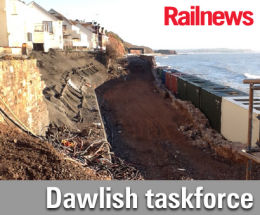Posted 19th March 2014 | 3 Comments
Taskforce to prepare south west resilience plans

NETWORK RAIL has announced that a rail taskforce involving a dozen national and regional organisations has been set up, marking the launch of a high-level study which is intended to protect the Great Western Main Line to Torbay, Plymouth and Cornwall from extreme weather.
The taskforce has been created following the severe damage caused by storms in the English Channel in early February, which demolished parts of the sea wall at Dawlish and the railway tracks that it carries.
Rail services to the far south west are currently still being replaced by buses through Devon, but Network Rail is hoping that through trains can be restored by 4 April, in time for the important Easter holidays. Easter effectively marks the beginning of the holiday season in the south west, a region where the local economy depends significantly on tourism.
Led by Network Rail, the taskforce also involves the Department for Transport, the Environment Agency, train operators and local authorities. The group will guide the strategic review on the viability of three long-term options – retaining the coastal route as it is, adding a second line or rerouting the main line entirely.
A scheme originally prepared by the Great Western Railway in the mid-1930s for an inland route at Dawlish has been dusted off, although the main reason for the GWR scheme was to add capacity, because quadrupling the existing line was not possible. It would, however, have also provided a valuable alternative route in times of bad weather, but the project was interrupted by the outbreak of war in 1939 and later abandoned.
Paul Harwood, strategy and planning director for Network Rail, said: “The railway in the south west has been helping move people and products for more than 175 years. We are taking action today to safeguard the railway for the next 175 years and beyond.
“The catastrophic destruction of the Dawlish sea wall by the storm in February has made clear the need to re-think the long-term strategy around changing climate and extreme weather. A robust railway is integral to national resilience and we are committed to keep passengers moving, every day and in every situation. We need to review what viable alternatives exist – otherwise there will be severe implications for local and national economies, mobility and connectivity across the region and the wider UK.”
Forecast sea level rises, passenger demand, the impact on communities and environmental, social and economic factors will be considered as part of the process, as well as examining engineering options to strengthen the sea wall. The group will also be informed by findings from a study which will examine five potential alternative routes.
The study is due to be completed by early summer, when it is expected to set out a choice of options for the Department for Transport to consider.
Reader Comments:
Views expressed in submitted comments are that of the author, and not necessarily shared by Railnews.

John Gilbert, Cradley
Ultimately I feel that the former GWR-planned route under the Haldon Hills must be resuscitated. However in the interim, and relatively quickly, the Southern route via Okehampton should be relayed as a single track - with curves set to permit the maximum speed possible - higher than originally by slewing the single track around sharp curves on what was a double-track formation to the optimum for speed. Also in the meantime, for goodness' sake GET ON with the relaying of the line between Bere Alston and Tavistock.....and right into the station site at Tavistock North despite the necessity of pulling down buildings now occupying the trackbed there. Let there be no more delay on this segment of the line from Plymouth to Exeter!!!
Garth, Dunkeld
The main (indeed sole realistic) integration for GW routes will be via Old Oak Common. I think you will find virtually all Western express services into/out of London calling there, possibly at the expense of some Reading calls. With a 2 min time penalty or so, they perhaps would pick up 20-25% of their load there, particularly with an easy transfer for Crossrail passengers. Somewhat akin to Watford Junction, or Haymarket in Edinburgh.
As for south/southwest routes, not before Crossrail 2, although that might just be accelerated.
Jonathan Brain, Hertfordshire
While an HS5 in parallel with the M5 is unjustifiable not seen any mention anywhere of how HS2 might integrate with West Country journeys - or Southampton / Brighton for that matter. Although only part of the route should be considered in these plans.